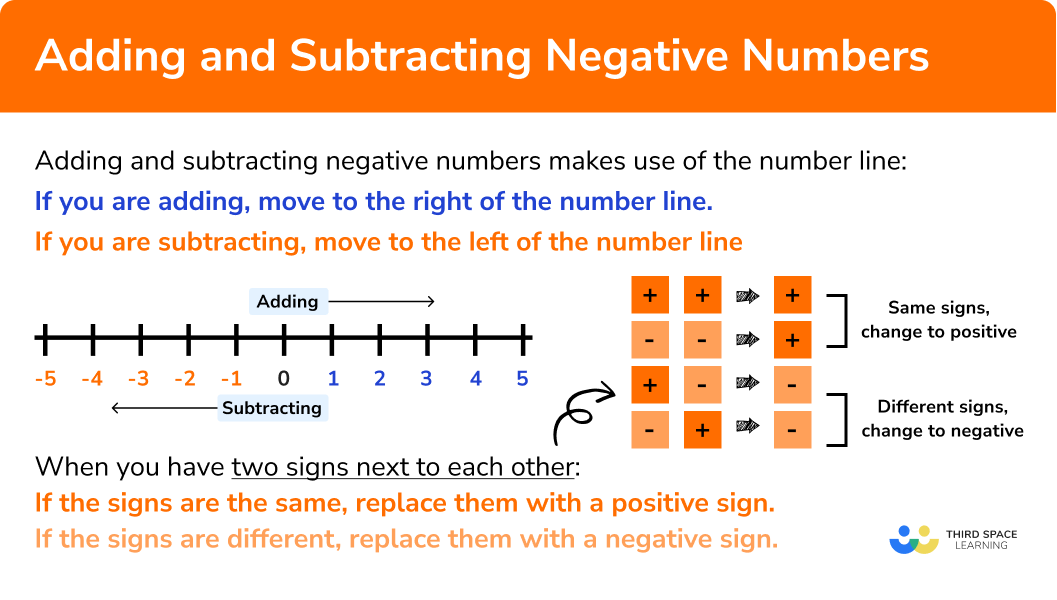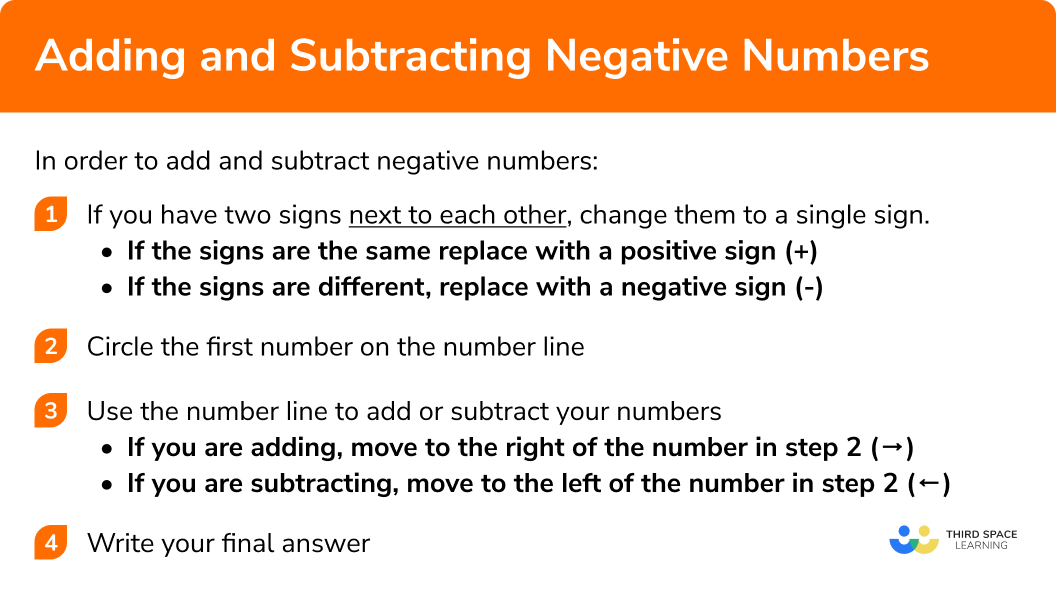GCSE Tutoring Programme
"Our chosen students improved 1.19 of a grade on average - 0.45 more than those who didn't have the tutoring."
In order to access this I need to be confident with:
ArithmeticThis topic is relevant for:

Adding And Subtracting Negative Numbers
Here we will learn about adding and subtracting negative numbers including what negative numbers are and how to add and subtract them.
There are also negative numbers worksheets and exam questions at worksheets based on Edexcel, AQA and OCR exam questions, along with further guidance on where to go next if you’re still stuck.
What are negative numbers?
Negative numbers are any numbers less than zero and that have a negative sign (−) in front of them.
Numbers greater than zero are referred to as positive numbers. If there is no sign in front of a number the number is positive.
On the number line below the numbers in orange are negative values and the blue numbers are positive values:
Just like you can add and subtract positive numbers, you can do the same with negative numbers.
When adding and subtracting negative numbers use a number line:
If you are adding, move to the right of the number line.
If you are subtracting, move to the left of the number line.
When you have two signs next to each other:
If the signs are the same replace with a positive sign.
If the signs are different, replace with a negative sign.
What do you need to remember when adding and subtracting negative numbers?

How to add and subtract negative numbers
In order to add and subtract negative numbers:
- If you have two signs next to each other, change them to a single sign.
If the signs are the same replace with a positive sign (+).
If the signs are different, replace with a negative sign (−). - Circle the first number on the number line.
- Use the number line to add or subtract your numbers.
If you are adding, move to the right of the number in step 2 (→).
If you are subtracting, move to the left of the number in step 2 (←). - Write your final answer.
Explain how to add and subtract negative numbers in 4 steps


Adding and subtracting negative numbers worksheet

Get your free adding and subtracting negative numbers worksheet of 20+ questions and answers. Includes reasoning and applied questions.
DOWNLOAD FREE
Adding and subtracting negative numbers worksheet

Get your free adding and subtracting negative numbers worksheet of 20+ questions and answers. Includes reasoning and applied questions.
DOWNLOAD FREEAdding and subtracting negative numbers examples
Example 1: adding a positive number
- If you have two signs next to each other, change them to a single sign.
If the signs are the same replace with a positive sign (+).
If the signs are different, replace with a negative sign (−).
In this case you do not have two signs next to each other.
2Circle the first number on the number line.
The first number in the question is
3Use the number line to add or subtract your numbers.
If you are adding, move to the right of the number in step 2 (→).
If you are subtracting, move to the left of the number in step 2 (←).
In this case we are adding the
4Write your final answer.
Example 2: adding a negative number
If you have two signs next to each other, change them to a single sign.
If the signs are the same replace with a positive sign (+).
If the signs are different, replace with a negative sign (−).
In this case you have a plus and a minus next to each other.
Since the signs are different, replace with a minus sign (−):
Circle the first number on the number line.
The first number in the question is
Use the number line to add or subtract your numbers.
If you are adding, move to the right of the number in step 2 (→).
If you are subtracting, move to the left of the number in step 2 (←).
In this case we are subtracting
Write your final answer.
Example 3: subtracting a positive number
If you have two signs next to each other, change them to a single sign.
If the signs are the same replace with a positive sign (+).
If the signs are different, replace with a negative sign (−).
In this case you do not have two signs next to each other.
Circle the first number on the number line.
The first number in the question is
Use the number line to add or subtract your numbers.
If you are adding, move to the right of the number in step 2 (→).
If you are subtracting, move to the left of the number in step 2 (←).
In this case we are subtracting
Write your final answer.
Example 4: subtracting a negative number
If you have two signs next to each other, change them to a single sign.
If the signs are the same replace with a positive sign (+)
If the signs are different, replace with a negative sign (−)
In this case you have a minus and a minus next to each other.
Since the signs are the same, replace with a plus sign (+)
Circle the first number on the number line.
The first number in the question is
Use the number line to add or subtract your numbers.
If you are adding, move to the right of the number in step 2 (→).
If you are subtracting, move to the left of the number in step 2 (←).
In this case we are adding
Write your final answer.
Example 5: mixed operations
If you have two signs next to each other, change them to a single sign.
If the signs are the same replace with a positive sign (+).
If the signs are different, replace with a negative sign (−).
In this case you have a minus and a minus next to each other.
Since the signs are the same, replace with a plus sign (+)
Circle the first number on the number line.
The first number in the question is
Use the number line to add or subtract your numbers.
If you are adding, move to the right of the number in step 2 (→).
If you are subtracting, move to the left of the number in step 2 (←).
In this case we are subtracting positive
Now we are adding
Write your final answer.
Example 6: worded question
Alina had
Let’s start with
If you have two signs next to each other, change them to a single sign.
If the signs are the same replace with a positive sign (+).
If the signs are different, replace with a negative sign (−).
In this case you do not have two signs next to each other.
Circle the first number on the number line.
The first number in the question is
Use the number line to add or subtract your numbers.
If you are adding, move to the right of the number in step 2 (→).
If you are subtracting, move to the left of the number in step 2 (←).
In this case we are subtracting
Because the scale on the number line below is in
Write your final answer.
She is overdrawn by .
Common misconceptions
- Greater negative does not mean a larger number
A common error is to assume that the larger a negative number is, the bigger number is.
E.g.
Related lessons
Adding and subtracting negative numbers is part of our series of lessons to support revision on negative numbers. You may find it helpful to start with the main negative numbers lesson for a summary of what to expect, or use the step by step guides below for further detail on individual topics. Other lessons in this series include:
Practice adding and subtracting negative numbers questions
1. Work out:




2. Work out:




There is a + - together so change it to a -
3. Work out:




4. Work out:




There is a - - together so change it to a +
5. Work out:




There is a + - together so change it to a -
6. At am in the morning, the temperature in Cambridge was ℃. By am the temperature had risen by ℃. What was the new temperature?




The calculation we need to do is
Adding and subtracting negative numbers GCSE questions
The table shows the temperature in Watford at different times of the day.
| Time of the Day | Temperature (℃) |
| 2am | -3 |
| 4am | 0 |
| 6am | 2 |
| 8am | 6 |
(a) Write down the lowest temperature.
(b) Find the difference between the warmest and the coldest temperature readings.
(3 marks)
(1)
Identifying the warmest and coldest temperatures, 6 and -3
(1)
(1)
2. Sarah has the following cards:
She is going to choose cards and subtract them.
(a) What is the largest possible number she can make?
(b) Sarah now decided to add the numbers rather than subtract them. What is the smallest possible number she can make?
(4 marks)
a) for identifying or or seen
(1)
correctly subtracting two numbers or seen
(1)
b) for identifying or
(1)
correctly adding two numbers or seen
(1)
3. Mr. and Mrs. Smith had £ in their bank account. At the end of the month they had to pay bills. They paid the telephone bill of £, utilities of £, car insurance £, and credit card bill of £. How much were the Smiths overdrawn?
(3 marks)
Finding the sum of the bills
(1)
Subtracting the cost of the four bills from the balance in the bank account
(1)
£
(1)
Learning checklist
You have now learned how to:
- Add and subtract integers both positive and negative
- Use negative numbers in context and calculate intervals across 0
The next lessons are
Still stuck?
Prepare your KS4 students for maths GCSEs success with Third Space Learning. Weekly online one to one GCSE maths revision lessons delivered by expert maths tutors.

Find out more about our GCSE maths tuition programme.